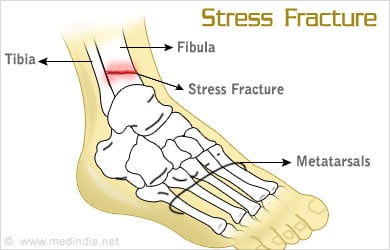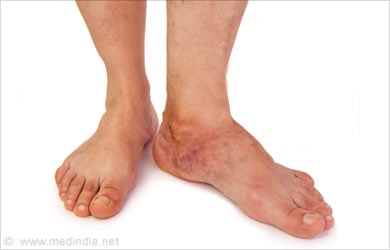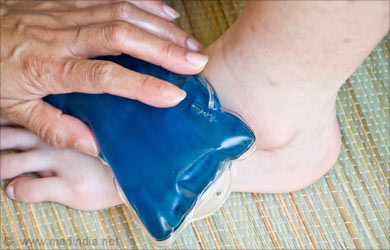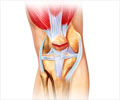- Stress Fractures of the Foot and Ankle - (http://orthoinfo.aaos.org/topic.cfm?topic=a00379)
- Stress fractures - (http://www.mayoclinic.org/diseases-conditions/stress-fractures/basics/definition/con-20029655)
About
Stress fractures are small fractures which often occur in the weight bearing bones of the lower leg and foot, mostly due to frequent repetition of an activity.
Stress fractures are small breaks in a bone that occur due to overuse or repeated application of force to a particular bone. It is commonly seen in the bones of the lower limbs in sports persons or military recruits.

Normally, a fracture occurs following an obvious trauma to the bone. However, in the case of stress fracture, an obvious trauma is absent. Normal human bones continuously undergo a process of remodeling. In this process, any small damage that occurs to the bone is replaced by new bone, thus maintaining the normal structure as far as possible. In some people like athletes who undergo rigorous workouts, the bones especially of the lower limbs do not get enough time to rest and repair. This results in the formation of small cracks in bones that are subject to extreme stress, resulting in a stress fracture. The occurrence of a stress fracture may be favored by the presence of predisposing factors like osteoporosis or hormonal issues that may further weaken the bone.
Like other fractures, symptoms of stress fractures include pain, tenderness and swelling in the affected area. The pain increases when additional stress is applied to the part and may be relieved with rest.
Stress fractures are diagnosed using imaging tests like MRI and bone scans. The patient is treated with resting the affected part and painkillers. Surgery may be required in some cases.
What are the Causes of Stress Fractures?
Intense physical activity or improper exercise techniques are the common reasons for the appearance of a stress fracture.
Causes of stress fractures include:
- Rigorous physical activity without adequate intervening rest periods
- Prolonged periods of stress on a particular bone
- Use of improper equipment or lack of good training while exercising or participating in sports
- Excessive weight-bearing activities

People at risk for stress fractures include:
- Sports persons and military recruits, who have to undergo rigorous physical activity
- Hormonal imbalances like thyroid problems that can weaken the bone. In addition, women athletes who suffer from irregular menstruation, eating disorders and osteoporosis also have hormonal issues that could predispose to stress fractures.
- Bone diseases like osteoporosis
- Nutritional deficiencies which again result in weak bones
- Altered foot structure like flat feet or high arches, which may put excessive pressure on particular bones
Stress Fractures - Symptoms and Signs
Symptoms of stress fractures include pain which increases with physical activity, tenderness and swelling of the affected part.
Stress fractures are most common in military recruits and sports persons involved in competitive sports like in tennis, athletics, gymnastics and basketball. Clinical features of stress fractures include the following:
- Stress fractures mostly occur in the weight bearing bones of the lower leg and foot, though other bones subject to repeated activity may also be affected.The bones of the foot commonly affected are the heel, the navicular bone which is a bone of the mid foot, the bones near the base of the second and third toes (which are referred to the second and third metatarsals)
- The patient complains of pain of the affected part which increases the activity and is progressive if not attended to. The pain reduces with rest.
- Swelling or bruising may be observed around the affected part.

How are Stress Fractures Diagnosed?
Stress fractures are diagnosed with the help of medical history, physical examination, and imaging tests such as MRI scan and bone scan.
Diagnosis of stress fractures is based on the following:
- A carefully taken medical history of the patient helps in identifying the presence of a stress fracture and the possible risk factors which led to the fracture.
- Physical examination can increase the suspicion of stress fracture.
- Imaging tests help in pinpointing the diagnosis. These include:
- Bone Scan
- MRI scans (Magnetic Resonance Imaging) are considered to be the most specific tests for identifying stress fractures. They also help distinguish between stress fractures and soft tissue injuries

- X-rays may be useful in diagnosing stress fractures that have been present for a long time, where signs of healing may be observed
How are Stress Fractures Treated?
Treatment of stress fractures involves adequate rest, medications and surgery in extreme cases.
Treatment of stress fractures includes the following:
- Rest: Taking rest and avoiding any physical or weight bearing activity is the primary step towards treating stress fractures. The affected bone has to be given sufficient time to heal. It takes around six to eight weeks for a stress fracture to heal.
- Ice packs: Application of ice packs may help reduce the pain and swelling around the affected area.

- Medications: NSAIDs (Non-steroidal anti-inflammatory drugs) help reduce the pain caused due to stress fractures; however, they may interfere with the bone healing process.
- Casts or Special Footwear: The physician may advise the use of special footwear or casts to stabilize the foot while the healing process is in effect. Crutches may also be advised to give rest to the foot.
- Surgery: Some cases of stress fracture may require surgery.
Prevention:
Stress fractures can be prevented by adopting the following measures:
- Any new physical activity should be taken up on a gradual basis and not suddenly. The body should be gradually conditioned to the new level of activity.
- Make sure that your diet contains enough calcium and vitamin D if you are an athlete. Take supplements if necessary.

- Switch to low impact activities like swimming and cycling if possible to reduce the pressure on the foot and ankle if you are frequently prone to stress fractures.
- Use proper and comfortable footwear that provide enough support to the weight bearing parts of the foot.






